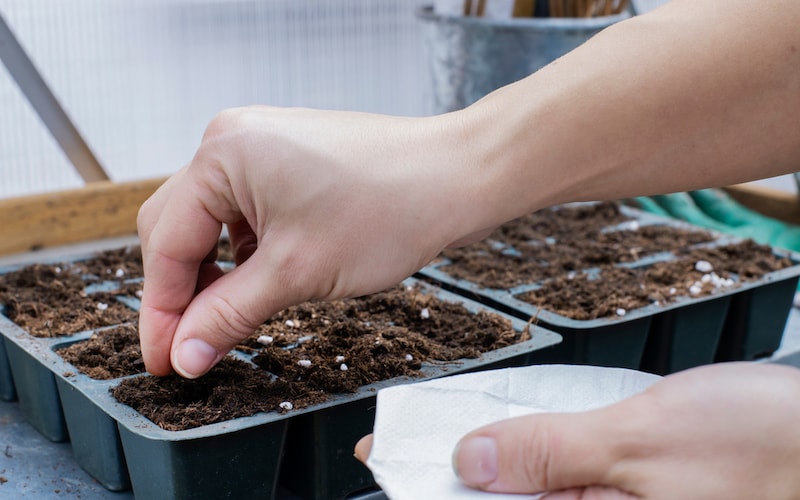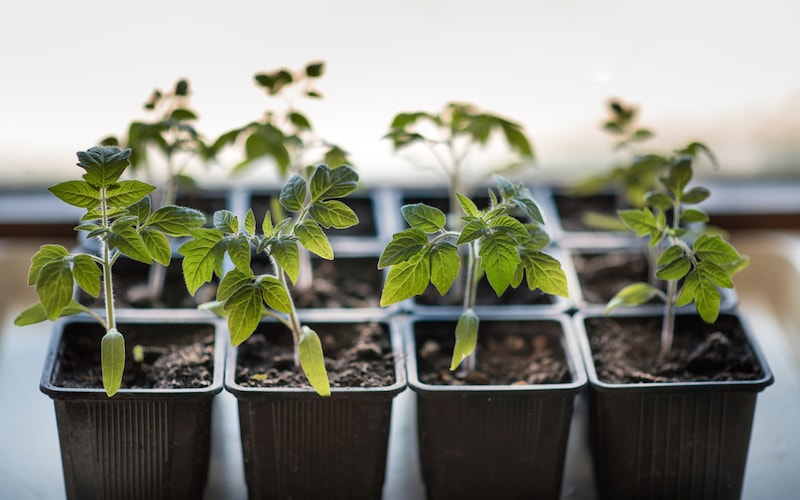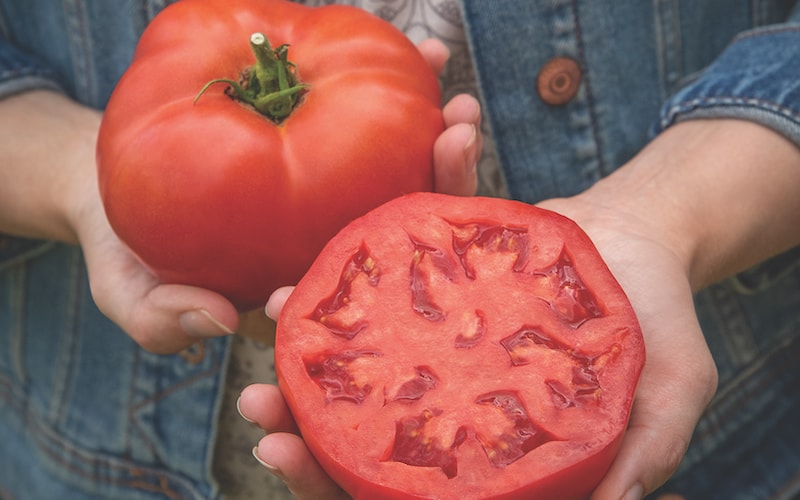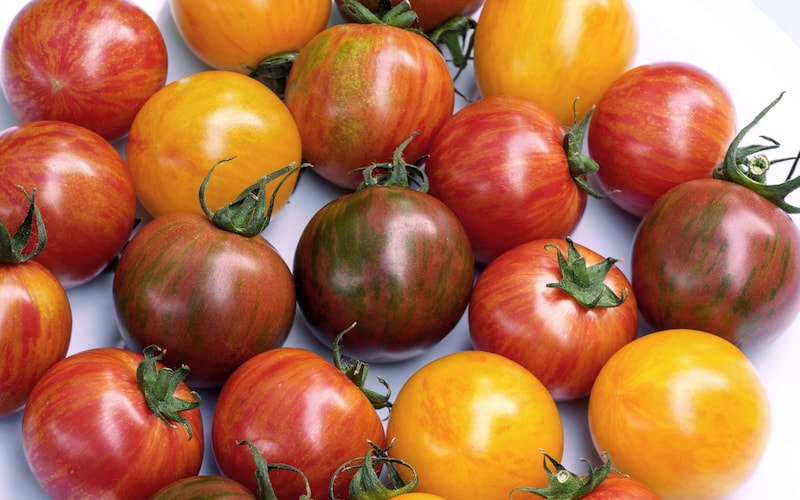Tomatoes are easy to grow and taste far superior to anything you can buy in a supermarket. Sowing tomato seeds is a cost-effective way to enjoy different sized, shaped and coloured fruits throughout the summer, but you can also purchase tomato plants if you’re looking for a head start. Here’s how to sow and grow tomatoes from seed.
How to choose the best tomatoes to grow from seed

Get a better yield by choosing the right tomato variety for your growing conditions
Image: Tomato ‘Toddler’ F1 from Suttons
One of the main advantages of growing your own tomatoes from seed is the wide choice of varieties available. Our handy tomato selector guide will help you find the best options for your growing space. Some varieties prefer a warm greenhouse, while others are perfectly suited to outdoor conditions. Others, like F1 Tomato ‘Crimson Cherry’, have been specially bred for blight resistance.
There are two main types of tomato from which to choose: cordon and bush. Cordon varieties need to be trained up and tied to a cane support as they grow, while bush varieties remain much more compact. There’s a tomato for every garden, including tumbling varieties that are ideal for window boxes or hanging baskets.
Finally, you’ll need to think about what type of tomato you most like to eat. Beefsteaks slice beautifully for burgers and sandwiches, plum tomatoes are perfect for cooking, salad tomatoes are a versatile all-rounder while cherry tomatoes make an excellent healthy snack. If you have space, grow some of each.
Where should I sow my tomato seeds?

Tomato seedlings need a sunny spot
Image: DZMITRY BYCHKOU/Shutterstock
Sow your seeds in a heated propagator or on a warm window sill in February. Alternatively, sow your seeds outdoors in an unheated greenhouse when temperatures rise in March. Tomato seeds germinate best when the soil is kept moist and there’s a stable temperature of 18ºC to 21ºC. Move them to a sunny spot when the seedlings start to poke through the soil surface.
How should I sow tomato seeds?

Sow a few tomato seeds per module
Image: Evgenia Tuzinska/Shutterstock
Here’s a step-by-step guide to sowing tomato seeds:
- Fill modular seed trays with a good quality seed compost.
- Make sure you water your trays well to fully dampen the soil.
- Press your seeds into the soil surface, sowing at least two per module.
- Lightly cover the seeds with compost and gently water them in.
- Remember to label your trays, especially if you’ve got a few varieties on the go, or you’ll have a surprise come harvest time.
- Expect to see germination 7 to 10 days after sowing.
Don’t worry if you’ve run out of time or space to sow seeds. Simply order a few tomato plants to hit the ground running.
How to care for tomato seedlings

Pot on your seedlings to give them plenty of room to grow
Image: Tibor Duris/Shutterstock
Once your seedlings emerge, keep them moist but not waterlogged. If you’re growing on a windowsill, turn the trays regularly so your seedlings grow straight. Too little light, or exposure to prolonged high temperatures will cause your seedlings to become leggy and spindly, so keep a close eye on them. When you can see at least one true leaf, pinch out the weaker seedling in each module to remove it.
When your strongest plantlets have a few true leaves each, it’s time to re-pot them into larger, individual pots and move them into a greenhouse or cold frame to grow on. Remember to harden them off for at least 10 days prior to moving them permanently outdoors, but wait until all risk of frost has passed.
Tomato growing: FAQs

Beefsteak tomatoes are huge and perfect for slicing
Image: Tomato ‘Burlesque F1’ from Suttons
To help you grow healthy tomatoes and troubleshoot problems, here are the answers to our most frequently asked questions:
- Why are the flowers on my tomatoes dropping off without setting fruit?
This may be due to temperatures being too high or too low. It could also be a lack of moisture in the soil or in the air around the flowers. Try misting your plants lightly with water as they flower to aid pollination and fruit setting. Make sure you ventilate and water your plants regularly as they grow.
- Why are patches on my tomato fruit not ripening?
Irregular ripening suggests your plants may have a potassium deficiency, or it may be that greenhouse temperatures are too high with too much strong sunlight. Solve this by providing shade, ventilating and regularly feeding your greenhouse plants with a balanced fertiliser.
- Why have my tomato plants died after developing dark blotches on the leaves?
Dark brown or black blotches on your leaves is a sure sign of the fungal disease tomato blight. Uproot dead or infected plants and dispose of the material by burning. Don’t add diseased plants to the compost heap, or it will spread around the garden. Grow resistant varieties like tomato ‘Crimson Crush’ or ‘Lizzano’ in the future — these plants may display symptoms but will grow away from infection and produce great yields.
- Why are the skins on my tomatoes tough?
Too much heat or sunlight can cause tough skins, as can low temperatures. Make sure you ventilate your greenhouse well and provide shading in very hot conditions. Water your plants regularly.
- Why have my tomatoes developed a brown area at the base of the fruit?
This is a sign of blossom end rot, which is a symptom of calcium deficiency. Use a calcium-rich tomato feed and be sure to allow water to permeate to the very deepest roots when watering. In very bad cases, try spraying your plants with a diluted calcium nitrate spray.
- Why are the skins on my tomatoes splitting?
Splitting tomato skins is a symptom of insufficient water. In outdoor grown plants, a quick onset of rain following a prolonged dry spell will cause skins to split too. Add organic matter to the soil to improve water retention and water all your plants regularly.
We hope this helps get your tomato seeds off to the best possible start. For more top tomato growing tips and tricks, check out our article: Best expert advice on how to grow tomatoes. We love to hear from you, so please share your tomato growing journey via our social channels or drop us an email.
Lead image: Tomato ‘Artisan Bumble Bee Mix’ from Suttons
Last Updated on December 3, 2025 by Suttons Horticultural Team





What does it mean when you say ” harden plants off “